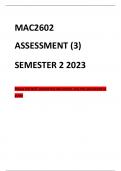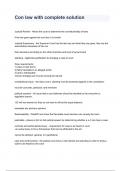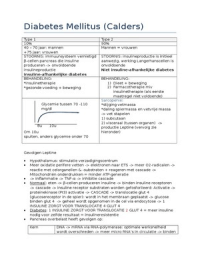Finance 2 (2023) – Problem Set 3
University of Amsterdam
Answers to IN CLASS exercises do not need to be handed in
The parts of exercises marked [IN CLASS] (e.g. 1g) will be completed during the tutorial
and answers to these parts do not need to be handed in via Canvas. Answers to the other
questions need to be completed before the deadline (see Canvas) and students need them to
participate in the tutorial.
Grading: only first problem set and bonus
We will only grade the first homework set in Canvas and then at the end of the course
determine if you have received the bonus or not. You will therefore not see a grade for each
homework set you have handed in. Feedback is possible during the tutorials.
Question 1 | Chapter 16 – Capital structure trade-off theory
XYZ Corp. is fully financed by equity. Its business assets are expected to generate free cash
flows of $26 million at the end of each year (lasting forever). The corporation has no other
assets like excess cash. The beta of XYZ free cash flows is 1.10 (irrespective of leverage). The
company has a profit tax rate of 35%. The current risk-free rate in the market is 5% per year
and the expected return of the market is 15% per year. Assume any tax shields have the
same risk as the underlying debt.
a. Calculate XYZ’s current firm value without leverage.
The corporation has decided to permanently increase its debt level to $10 million and
expects the debt to still be risk-free.
b. Calculate the present value of XYZ’s tax shield if the firm has $10 million in permanent
debt.
c. Calculate XYZ’s firm value with $10 million in permanent debt.
The corporation is also considering permanently increasing its debt level to $45 million but is
worried about the costs of financial distress. Consultants have estimated that with the new
debt level the free cash flows will be reduced from $26 million to $22 million per year due to
the costs of financial distress.
d. Calculate the present value of the costs of financial distress with $45 million in
permanent debt.
e. Calculate XYZ’s firm value with $45 million in permanent debt and distress costs.
f. What debt level (no debt, $10 million or $45 million) would you advise XYZ to take?
The CEO of another corporation has seen the calculation for tax shields and asks the
following question: Does a higher tax rate induce higher market values for firms?
g. How would you respond to this question? [IN CLASS]
1
,Question 2 | Chapter 16 – Capital structure trade-off theory
A financial analyst argues that in 2018 the capital market was not efficient since the
valuation of several firms was lower due to financial distress but these firms never ran into
financial trouble in the years to follow. How would you respond to this statement? [IN
CLASS]
Question 3 | Chapter 16 – Capital structure and agency costs
Consider a firm whose only asset is a plot of vacant land, and whose only liability is debt of
$15 million due in one year. If left vacant, the land will be worth $12 million in one year.
Alternatively, the firm can develop the land at an upfront cost of $22 million. The developed
land will be worth $38 million in one year. Suppose the risk-free interest rate is 5%, assume
all cash flows (for debt, for equity and for the project) are risk-free, and assume there are no
taxes.
Suppose the firm chooses not to develop the land.
a. What is the value of the firm’s debt today? Will the firm go bankrupt?
Hint: calculate the firm’s cash flows at time 1 and distribute them over debt and equity
(with debt having priority) and then discount the cash flows of debt to time 0 to get the
value of debt today.
b. What is the value of the firm’s equity today?
c. What is the NPV of developing the land? Should the land be developed?
Suppose now the firm raises the $22 million from equity holders and develops the land.
d. Show that the value of the debt is now $14.28.
e. What is the value of the firm’s equity today?
f. Given your answer to part (e), would equity holders be willing to provide the $22 million
needed to develop the land?
Hint: compare the additional payoffs to shareholders to the amount they invested.
g. What do you call the type of problem encountered under f?
h. What can the bank do to solve the problem described under f? [IN CLASS]
i. What is the highest nominal value of the debt the bank can charge in order to remove
the problem described under g? [IN CLASS]
2
, Problem set 3
Question 1
XYZ Corp. is fully financed by equity. Its business assets are expected to generate free
cash flows of $26 million at the end of each year (lasting forever). The corporation has no
other assets like excess cash. The beta of XYZ free cash flows is 1.10 (irrespective of
leverage). The company has a profit tax rate of 35%. The current risk-free rate in the
market is 5% per year and the expected return of the market is 15% per year. Assume any
tax shields have the same risk as the underlying debt.
a.
XYZ’s current firm value without leverage: we compute the unlevered firm value by
discounting its free cash flow with the unlevered cost of capital (pre-tax WACC). We use
the Capital Asset Price Model and the asset beta to calculate the unlevered cost of
capital.
r(wacc) = r𝖿 + β * (r - r𝖿) = 5% + 1.1 * (15% - 5%) = 16%
V ͧ = FCF / r = .16 = $162.5 million
The corporation has decided to permanently increase its debt level to $10 million and
expects the debt to still be risk-free.
University of Amsterdam
Answers to IN CLASS exercises do not need to be handed in
The parts of exercises marked [IN CLASS] (e.g. 1g) will be completed during the tutorial
and answers to these parts do not need to be handed in via Canvas. Answers to the other
questions need to be completed before the deadline (see Canvas) and students need them to
participate in the tutorial.
Grading: only first problem set and bonus
We will only grade the first homework set in Canvas and then at the end of the course
determine if you have received the bonus or not. You will therefore not see a grade for each
homework set you have handed in. Feedback is possible during the tutorials.
Question 1 | Chapter 16 – Capital structure trade-off theory
XYZ Corp. is fully financed by equity. Its business assets are expected to generate free cash
flows of $26 million at the end of each year (lasting forever). The corporation has no other
assets like excess cash. The beta of XYZ free cash flows is 1.10 (irrespective of leverage). The
company has a profit tax rate of 35%. The current risk-free rate in the market is 5% per year
and the expected return of the market is 15% per year. Assume any tax shields have the
same risk as the underlying debt.
a. Calculate XYZ’s current firm value without leverage.
The corporation has decided to permanently increase its debt level to $10 million and
expects the debt to still be risk-free.
b. Calculate the present value of XYZ’s tax shield if the firm has $10 million in permanent
debt.
c. Calculate XYZ’s firm value with $10 million in permanent debt.
The corporation is also considering permanently increasing its debt level to $45 million but is
worried about the costs of financial distress. Consultants have estimated that with the new
debt level the free cash flows will be reduced from $26 million to $22 million per year due to
the costs of financial distress.
d. Calculate the present value of the costs of financial distress with $45 million in
permanent debt.
e. Calculate XYZ’s firm value with $45 million in permanent debt and distress costs.
f. What debt level (no debt, $10 million or $45 million) would you advise XYZ to take?
The CEO of another corporation has seen the calculation for tax shields and asks the
following question: Does a higher tax rate induce higher market values for firms?
g. How would you respond to this question? [IN CLASS]
1
,Question 2 | Chapter 16 – Capital structure trade-off theory
A financial analyst argues that in 2018 the capital market was not efficient since the
valuation of several firms was lower due to financial distress but these firms never ran into
financial trouble in the years to follow. How would you respond to this statement? [IN
CLASS]
Question 3 | Chapter 16 – Capital structure and agency costs
Consider a firm whose only asset is a plot of vacant land, and whose only liability is debt of
$15 million due in one year. If left vacant, the land will be worth $12 million in one year.
Alternatively, the firm can develop the land at an upfront cost of $22 million. The developed
land will be worth $38 million in one year. Suppose the risk-free interest rate is 5%, assume
all cash flows (for debt, for equity and for the project) are risk-free, and assume there are no
taxes.
Suppose the firm chooses not to develop the land.
a. What is the value of the firm’s debt today? Will the firm go bankrupt?
Hint: calculate the firm’s cash flows at time 1 and distribute them over debt and equity
(with debt having priority) and then discount the cash flows of debt to time 0 to get the
value of debt today.
b. What is the value of the firm’s equity today?
c. What is the NPV of developing the land? Should the land be developed?
Suppose now the firm raises the $22 million from equity holders and develops the land.
d. Show that the value of the debt is now $14.28.
e. What is the value of the firm’s equity today?
f. Given your answer to part (e), would equity holders be willing to provide the $22 million
needed to develop the land?
Hint: compare the additional payoffs to shareholders to the amount they invested.
g. What do you call the type of problem encountered under f?
h. What can the bank do to solve the problem described under f? [IN CLASS]
i. What is the highest nominal value of the debt the bank can charge in order to remove
the problem described under g? [IN CLASS]
2
, Problem set 3
Question 1
XYZ Corp. is fully financed by equity. Its business assets are expected to generate free
cash flows of $26 million at the end of each year (lasting forever). The corporation has no
other assets like excess cash. The beta of XYZ free cash flows is 1.10 (irrespective of
leverage). The company has a profit tax rate of 35%. The current risk-free rate in the
market is 5% per year and the expected return of the market is 15% per year. Assume any
tax shields have the same risk as the underlying debt.
a.
XYZ’s current firm value without leverage: we compute the unlevered firm value by
discounting its free cash flow with the unlevered cost of capital (pre-tax WACC). We use
the Capital Asset Price Model and the asset beta to calculate the unlevered cost of
capital.
r(wacc) = r𝖿 + β * (r - r𝖿) = 5% + 1.1 * (15% - 5%) = 16%
V ͧ = FCF / r = .16 = $162.5 million
The corporation has decided to permanently increase its debt level to $10 million and
expects the debt to still be risk-free.












